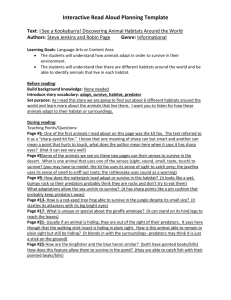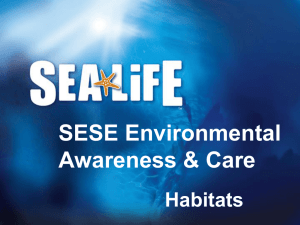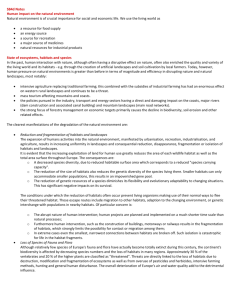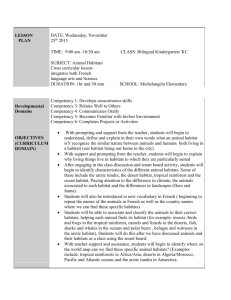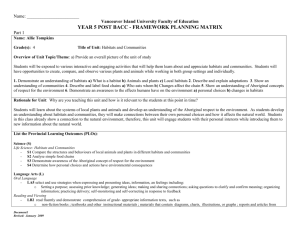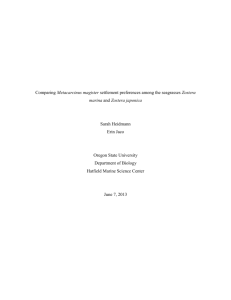Unpacking Outcomes - North East School Division
advertisement
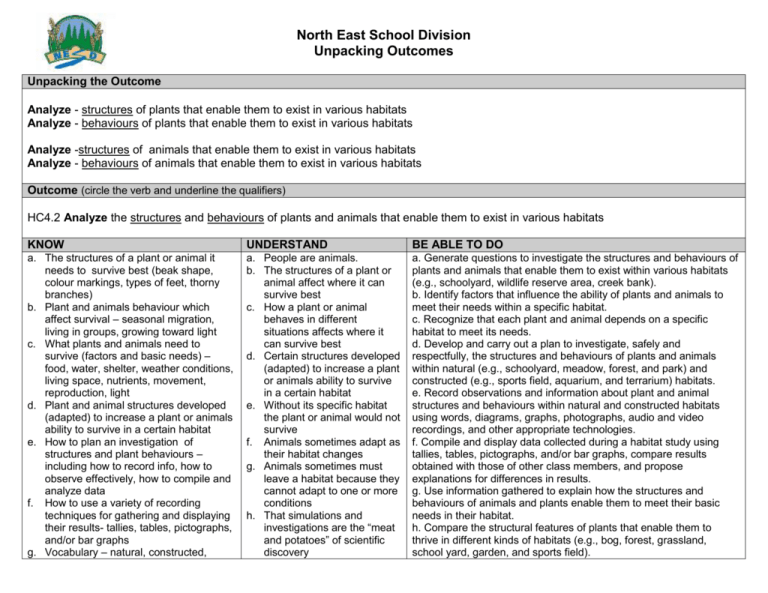
North East School Division Unpacking Outcomes Unpacking the Outcome Analyze - structures of plants that enable them to exist in various habitats Analyze - behaviours of plants that enable them to exist in various habitats Analyze -structures of animals that enable them to exist in various habitats Analyze - behaviours of animals that enable them to exist in various habitats Outcome (circle the verb and underline the qualifiers) HC4.2 Analyze the structures and behaviours of plants and animals that enable them to exist in various habitats KNOW UNDERSTAND BE ABLE TO DO a. The structures of a plant or animal it needs to survive best (beak shape, colour markings, types of feet, thorny branches) b. Plant and animals behaviour which affect survival – seasonal migration, living in groups, growing toward light c. What plants and animals need to survive (factors and basic needs) – food, water, shelter, weather conditions, living space, nutrients, movement, reproduction, light d. Plant and animal structures developed (adapted) to increase a plant or animals ability to survive in a certain habitat e. How to plan an investigation of structures and plant behaviours – including how to record info, how to observe effectively, how to compile and analyze data f. How to use a variety of recording techniques for gathering and displaying their results- tallies, tables, pictographs, and/or bar graphs g. Vocabulary – natural, constructed, a. People are animals. b. The structures of a plant or animal affect where it can survive best c. How a plant or animal behaves in different situations affects where it can survive best d. Certain structures developed (adapted) to increase a plant or animals ability to survive in a certain habitat e. Without its specific habitat the plant or animal would not survive f. Animals sometimes adapt as their habitat changes g. Animals sometimes must leave a habitat because they cannot adapt to one or more conditions h. That simulations and investigations are the “meat and potatoes” of scientific discovery a. Generate questions to investigate the structures and behaviours of plants and animals that enable them to exist within various habitats (e.g., schoolyard, wildlife reserve area, creek bank). b. Identify factors that influence the ability of plants and animals to meet their needs within a specific habitat. c. Recognize that each plant and animal depends on a specific habitat to meet its needs. d. Develop and carry out a plan to investigate, safely and respectfully, the structures and behaviours of plants and animals within natural (e.g., schoolyard, meadow, forest, and park) and constructed (e.g., sports field, aquarium, and terrarium) habitats. e. Record observations and information about plant and animal structures and behaviours within natural and constructed habitats using words, diagrams, graphs, photographs, audio and video recordings, and other appropriate technologies. f. Compile and display data collected during a habitat study using tallies, tables, pictographs, and/or bar graphs, compare results obtained with those of other class members, and propose explanations for differences in results. g. Use information gathered to explain how the structures and behaviours of animals and plants enable them to meet their basic needs in their habitat. h. Compare the structural features of plants that enable them to thrive in different kinds of habitats (e.g., bog, forest, grassland, school yard, garden, and sports field). structures, behaviours, habitat, observation, data, tally, table, pictograph, bar graph, basic needs, features, thrive, simulation, visibility, adaptation h. How to design and carry out a simulation and make predictions i. j. That making predictions is easier, the more we know about something That data helps us see patterns and make predicitons i. Design and carry out a simulation to explore how the appearance of a plant or animal affects its visibility. j. Predict the structural and behavioural adaptations required for a real or imagined animal to live in a particular habitat, either real or imagined. ESSENTIAL QUESTIONS a) b) c) d) e) f) g) h) i) Could we begin seeing “new” structures/behaviours on “old” animals? Could we begin seeing “new” structures/behaviours on “old” plants? Can people keep plants or animals from becoming extinct? Are all extinctions the fault of people and if not, can people impact that? How do we know people are animals? How to structures and behaviours affect habitat choices for plants and animals? How are adaptations vital to species survival? Why are habitats so important? Why do some animals leave habitats? Why are simulations, investigations and data so important in scientific work? How can we use the information we learn from them?



